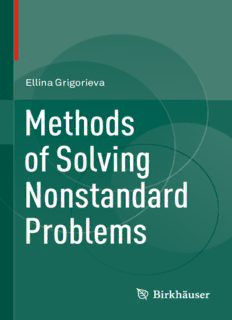Table Of ContentEllina Grigorieva
Methods
of Solving
Nonstandard
Problems
Methods of Solving Nonstandard Problems
Ellina Grigorieva
Methods of Solving
Nonstandard Problems
EllinaGrigorieva
MathematicsandComputerScience
TexasWoman’sUniversity
Denton,TX,USA
ISBN978-3-319-19886-6 ISBN978-3-319-19887-3 (eBook)
DOI10.1007/978-3-319-19887-3
LibraryofCongressControlNumber:2015945585
Mathematics Subject Classification (2010): 00A07, 26A09, 26A15, 26A48, 26C10, 26D05, 26D07,
97H20,97H30,97G60,08A50,11B25,11A05,11B65,11C05,11D25,11D72,11J81,65Hxx,65H04,
65H05,65H10
SpringerChamHeidelbergNewYorkDordrechtLondon
©SpringerInternationalPublishingSwitzerland2015
Thisworkissubjecttocopyright.AllrightsarereservedbythePublisher,whetherthewholeorpartof
the material is concerned, specifically the rights of translation, reprinting, reuse of illustrations,
recitation, broadcasting, reproduction on microfilms or in any other physical way, and transmission
or information storage and retrieval, electronic adaptation, computer software, or by similar or
dissimilarmethodologynowknownorhereafterdeveloped.
The use of general descriptive names, registered names, trademarks, service marks, etc. in this
publicationdoesnotimply,evenintheabsenceofaspecificstatement,thatsuchnamesareexempt
fromtherelevantprotectivelawsandregulationsandthereforefreeforgeneraluse.
Thepublisher,theauthorsandtheeditorsaresafetoassumethattheadviceandinformationinthis
book are believed to be true and accurate at the date of publication. Neither the publisher nor the
authors or the editors give a warranty, express or implied, with respect to the material contained
hereinorforanyerrorsoromissionsthatmayhavebeenmade.
Printedonacid-freepaper
Springer International Publishing AG Switzerland is part of Springer Science+Business Media
(www.springer.com)
To my beautiful daughter, Sasha
And to my wonderful parents, Natali and
Valery Grigoriev
Your encouragement made this book possible
And to my university mentor and scientific
advisor academician, Stepanov Nikolay
Fedorovich
Without your help and brilliant mind my
career as a scientist would not be successful!
Preface
Many universities offer problem-solving courses for students majoring in
mathematics and mathematics teaching. However, I have noticed over the years
that many graduates are afraid of solving complex problems and try to escape
solvingchallengingmathproblemsiftheycan.Whyshouldwebeafraid?Ourfight
or flight response either leads us to take up the struggle with the problems or to
avoidmathematicswithapassion.
Itisnotasecretthatwetendtolikethingsthatwearenaturallygoodat.Welove
something if we have visible, continuous success. Such success comes only with
hardwork.WhenIwasyoung,Imyselfhaddifficultiesingeometryclass,whichI
describedinmybookMethodsofSolvingComplexGeometryProblems(Springer,
2013). I later went on to win various Math Olympiads and graduate from
Lomonosov Moscow State University (MGU) summa cum laude, defend a Ph.D.
inMathematicalandPhysicalSciences,andpublishover60papersinthefieldsof
differentialequations,gametheory, economics,andoptimal control theory. Some
initialsuccessinmathematicscanleadtogreatersuccessesovertime.
AtMoscowState,attheendofeachsemesterthestudentshadtopassfouroral
examsgivenbyrenownedprofessors.Theprofessorscouldaskanytrickyquestion
onthetopicoftheexaminationticket.WhenIwaspreparingforsuchexamsandin
order to get an “A,” I did not try to memorize all the definitions and proofs,
but rather I tried to develop a “global” understanding of the subject. I thought of
possible questions that an examiner could ask me and tried to predict the type of
problemthatIcouldbeaskedtosolve.IdevelopedmyownwayoflearningandI
wanttoshareitwithyou.
For over 30 years, whenever I spotted an especially interesting or tricky prob-
lem,Iaddedittomynotebooksalongwithmyoriginalsolutions.I’veaccumulated
thousandsoftheseproblems.Iusethemeverydayinmyteachingandincludemany
of them in this book. Before accepting an academic position at a university, I
workedasateacheratUrsulineAcademyofDallasandusedmyproblem-solving
techniquesinmystudents’collegepreparation.Iwaspleasedtoreceiveapprecia-
tionlettersfromMITandHarvardwheresomeofmystudentswereadmitted.
vii
viii Preface
Ifyouarestrugglingwithmath,thisbookisforyou.Mostmathbooksstartfrom
theoreticalfacts,giveoneortwoexamples,andthenasetofproblems.Inthisbook,
almost every statement is followed by problems. You are not just memorizing a
theorem—youapplytheknowledgeimmediately.Uponseeingasimilarproblemin
thehomeworksection,youwillbeabletorecognizeandsolveit.
Although each section of the book can be studied independently, the book is
constructed to reinforce patterns developed at stages throughout the book. This
helps you see how math topics are connected. The book can be helpful for self-
education,forpeoplewhowanttodowellinmathclasses,orforthosepreparingfor
competitions.Thebookisalsomeantformathteachersandcollegeprofessorswho
wouldliketouseitasanextraresourceintheirclassroom.
What Is This Book About?
This book will teach you about functions and how properties of functions can be
usedtosolvenonstandardequations,systemsofequations,andinequalities.When
wesay“nonstandard,”onecanthinkofavarietyofproblemsthatappearunusual,
intractable, or complex. However, we can also say that nonstandard can indicate
amethod thatisoppositetoastandardorcommonwayofthinking.Forexample,
mostofthetimesweneedtofindthemaximalorminimalvalueofafunction,the
standard method would be to use the derivative of a function. However, under
certain conditions, maximum and minimum problems can be solved through
knowledge of some properties, such as boundedness of functions, and perhaps
with the application of known inequalities. Another example of a nonstandard
problem would be a word problem whose solution is restricted to the integers or
thatmaybereducedtoanonlinearsystemwithmorevariablesthanthenumberof
the equations. A nonstandard problem is one that does not yield easily to direct
solution.Thenonstandardmethodofproblemsolvingistheprocessofsynthesizing
connections between seemingly disassociated areas of mathematics and selecting
appropriate generalizations, so that known constraints coincide to yield the solu-
tion.TheyaretheSudokupuzzlesofmathematics.
Standard methods and relevant formulas make up the context for the problem
sets and are presented in each chapter together with simple problems for illustra-
tion.Basicknowledgeofsecondaryschoolmathematicsisassumed.Forexample,
if a probleffiffimffiffi is to solve a quadratic equation x2(cid:2)7xþ2¼0, then its roots,
p
x ¼7(cid:3) 41, can be found using the well-known quadratic formula. What if I
1,2 2
change the problem a little bit and ask you nowto prove that for a new quadratic
equation,x2þaxþ1(cid:2)b¼0withnaturalroots,thequantitya2þb2 cannotbea
prime number? Would standard methods and the quadratic formula help to solve
thisproblem?
Preface ix
The problem has two parameters a and b, and is restricted to the set of natural
numbers.Hence,inordertosolvethisproblem,weneedtoknowmorethanjusta
quadraticformula;weneedtohaveamethodthatwillprovideanotherconstraintof
the solution. In this case, for example, Vieta’s formula and the knowledge of
elementarynumbertheorymightbehelpful.
Letmegiveyounowthefollowingproblem:
Solvetheinequality ðx2þ2xþ2Þx (cid:4)1.
In this problem, we do not have any parameters, but the problem is no less
difficult than the previous one. The expression inside parentheses is a quadratic
raised to the power of x. Would knowledge of solving standard quadratic or
exponential inequalities help here? Do we need to do anything with the unit on
the right-hand side? Did you hear anything about monotonic functions in the past
thatmightbehelpful?
Let’sconsider thesolutionofcubicequations.Many ofmystudentsknow that
the Rational Zero Theorem or the Fundamental Theorem of Algebra might be of
help.Somewhotookacourseonthehistoryofmathematicshaveheardaboutthe
Cardanoformula.Theseformulasmaybeapplicable,buttheymaynotbeadequate
tosolvethequestion.
Many interesting Olympiad problems can be solved by using nonstandard and
otherwisenonobviousapproaches.Forexample,whatwouldyoudoifIaskyouto
findthevalueofaparameteraforwhichthecubicfunction fðxÞ¼x3(cid:2)3x(cid:2)ahas
preciselytwox-intercepts?Whatconditiononawouldbenecessarysothatitwould
haveoneorthreex-intercepts?Playingwithagraphingcalculatormightgiveyoua
hint,butnocalculatorsareallowedintheMathematicsOlympiad.
Knowledgeofnonstandardmethodsofproblemsolvingisimportantbecausewe
developadeeperunderstandingofmathematicsfromtheseoddquestions.Mathe-
matics is not a disjointed collection of topics but rather a unified whole. The
connections between fields are what tie them together. The structures of these
mathematicalfieldscanbelearnedinamorepowerfulwaybyunderstandingthese
connectionsgainedbytheexplorationofthesenonstandardproblems.
There is a method for developing solutions to nonstandard problems. After
solving some especially interesting problem, look for a generalization and try to
see an application of that method in the solution of other problems. Usually, a
nonstandardproblemrequiresknowledgeofseveralaspectsofmathematicsandcan
be solved only with the knowledge of some particular fact from a seemingly
disassociatedfield.
If students see an elegant solution but do not apply the approach to other
problems, they will not remember it, just as nobody remembers phone numbers
thesedays.However,ifateacherusesandreusesthesameapproachthroughoutthe
entire curriculum, students will remember it and learn to value the beauty of the
method.ThisiswhatIpracticeinmyteachingandsharewithyouinthisbook.
Description:This book, written by an accomplished female mathematician, is the second to explore nonstandard mathematical problems – those that are not directly solved by standard mathematical methods but instead rely on insight and the synthesis of a variety of mathematical ideas. It promotes mental activity

